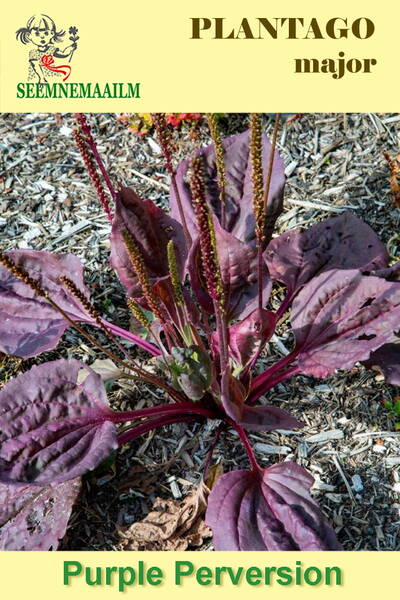Perennial plant of the Plantaginaceae family.
The species grows in Asia, Europe, America: meadows, roadsides, wastelands. Well known in traditional medicine.
Height of flowering plant: up to 35 cm.
Color of spike-shaped inflorescence: white.
Natural flowering period: May - August.
Winter hardiness zones: Z3 - Z9.
Looks decorative in a pot, but can also be used as a groundcover plant. Gives self-seeding in suitable places. Resistant to salt.
It is distinguished by highly decorative, bright and more or less "corrugated" leaves of a broad oval shape, collected in a lush basal rosette.
The color of the foliage is rich green-violet, turning into a bright green color in the center of the rosette. As it ages, the shade of the foliage can change to either dark red or dark green.
The plant is very undemanding in care, light-loving (in complete shade it loses the brightness of its color).
The crop prefers well-lit or shaded areas and fertile soil of neutral or weak acidity (pH 5.5-7). However, plantain will also grow on other soils, it does not tolerate only extremely alkaline, as well as excessively heavy swampy areas. Pests and diseases practically do not affect this plant.
Plantain seeds are sown on the site before winter so that they undergo natural stratification (1.0 g = 4000 seeds).
They are placed in shallow furrows at a distance of about 30-50 cm from each other and sprinkled with a layer of soil at least 0.5 cm thick - in the spring you will see friendly shoots.
If you are going to sow plantain seeds in the spring, you will need a long preliminary cold stratification. Sow the seeds in the ground early, immediately after the soil has thawed and you have loosened it well to a shallow depth. Plantain crops do not need thinning, but weeds nearby should be removed, especially during the initial growth period of the crop.
Caring for plantain is not difficult. From time to time, you need to water the bushes, loosen the soil between them and, if desired (or on poor soils), feed the plants 2-3 times per season. Use nitrophoska or any other nitrogen fertilizer for rapid growth of vegetative mass.
Plantain reproduces well by self-seeding (if you do not want this, then remove faded spikelets in time).
Eng.: Common plantain, broad-leafed plantain, great plantain, greater plantain, rib-grass, ribwort, ripple-grass, waybread, white man's foot.












